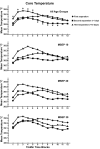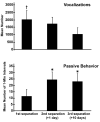Persistent sensitization of depressive-like behavior and thermogenic response during maternal separation in pre- and post-weaning guinea pigs
- PMID: 21953581
- PMCID: PMC3270115
- DOI: 10.1002/dev.20609
Persistent sensitization of depressive-like behavior and thermogenic response during maternal separation in pre- and post-weaning guinea pigs
Abstract
Early attachment disruption is thought to promote later onset of depressive illness through a process involving sensitization. Maternal separation in guinea pig pups produces depressive-like behavior and core body temperature fluctuations that appear to be mediated by proinflammatory activity. In pups near the age of weaning (~20 days of age), these responses are increased during repeated separations occurring over several days. Here, enhanced depressive-like behavior and core body temperature responses were observed during repeated separations in guinea pigs from ~10 to 30 days of age. The sensitization lasted for more than a week, with the greatest temperature response occurring during the final separation. These results demonstrate persisting sensitization of behavioral and thermogenic responses to maternal separation over the age range in which these responses are known to occur. The findings are consistent with the hypothesis that proinflammatory activity contributes to the sensitization response and provide further suggestion that the impact of early attachment disruption on susceptibility to depression may involve proinflammatory processes.
Copyright © 2011 Wiley Periodicals, Inc.
Figures





Similar articles
-
Filial attachment and its disruption: insights from the guinea pig.Dev Psychobiol. 2014 Dec;56(8):1747-54. doi: 10.1002/dev.21215. Epub 2014 Apr 14. Dev Psychobiol. 2014. PMID: 24733361 Free PMC article. Review.
-
Naproxen attenuates sensitization of depressive-like behavior and fever during maternal separation.Physiol Behav. 2015 Feb;139:34-40. doi: 10.1016/j.physbeh.2014.11.030. Epub 2014 Nov 14. Physiol Behav. 2015. PMID: 25449392 Free PMC article.
-
Sensitization of depressive-like behavior during repeated maternal separation is associated with more-rapid increase in core body temperature and reduced plasma cortisol levels.Physiol Behav. 2012 Feb 1;105(3):861-7. doi: 10.1016/j.physbeh.2011.10.026. Epub 2011 Nov 3. Physiol Behav. 2012. PMID: 22079581 Free PMC article.
-
Maternal separation increases later immobility during forced swim in guinea pig pups: evidence for sensitization of a depressive-like state.Dev Psychobiol. 2017 Jan;59(1):128-132. doi: 10.1002/dev.21444. Epub 2016 Jul 4. Dev Psychobiol. 2017. PMID: 27374759 Free PMC article.
-
Early attachment-figure separation and increased risk for later depression: potential mediation by proinflammatory processes.Neurosci Biobehav Rev. 2010 May;34(6):782-90. doi: 10.1016/j.neubiorev.2009.03.012. Epub 2009 Apr 5. Neurosci Biobehav Rev. 2010. PMID: 20359585 Free PMC article. Review.
Cited by
-
Sensitization of depressive-like behavior is attenuated by disruption of prostaglandin synthesis days following brief early attachment-figure isolation.Dev Psychobiol. 2022 Mar;64(2):e22237. doi: 10.1002/dev.22237. Dev Psychobiol. 2022. PMID: 35191529 Free PMC article.
-
Central neuroimmune activity and depressive-like behavior in response to repeated maternal separation and injection of LPS.Physiol Behav. 2019 Feb 1;199:366-374. doi: 10.1016/j.physbeh.2018.11.040. Epub 2018 Nov 30. Physiol Behav. 2019. PMID: 30508550 Free PMC article.
-
Psychological Stress, Its Reduction, and Long-Term Consequences: What Studies with Laboratory Animals Might Teach Us about Life in the Dog Shelter.Animals (Basel). 2020 Nov 7;10(11):2061. doi: 10.3390/ani10112061. Animals (Basel). 2020. PMID: 33171805 Free PMC article. Review.
-
Stability and change: Stress responses and the shaping of behavioral phenotypes over the life span.Front Zool. 2015 Aug 24;12 Suppl 1(Suppl 1):S18. doi: 10.1186/1742-9994-12-S1-S18. eCollection 2015. Front Zool. 2015. PMID: 26816517 Free PMC article. Review.
-
Filial attachment and its disruption: insights from the guinea pig.Dev Psychobiol. 2014 Dec;56(8):1747-54. doi: 10.1002/dev.21215. Epub 2014 Apr 14. Dev Psychobiol. 2014. PMID: 24733361 Free PMC article. Review.
References
-
- Berryman JC. Guinea pig vocalizations: their structure, causation and function. Zeitschrift für Tierpsychologie. 1976;41:80–106. - PubMed
-
- Black PH. The inflammatory response is an integral part of the stress response: Implications for atherosclerosis, insulin resistance, type II diabetes and metabolic syndrome X. Brain, Behavior, and Immunity. 2003;17:350–364. - PubMed
-
- Blatteis CM, Quan N, Xin L, Ungar AL. Neuromodulation of acute-phase responses to interleukin-6 in guinea pigs. Brain Research Bulletin. 1990;25:859–901. - PubMed
Publication types
MeSH terms
Grants and funding
LinkOut - more resources
Full Text Sources
Medical

